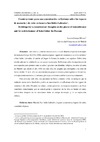Please use this identifier to cite or link to this item:
https://accedacris.ulpgc.es/jspui/handle/10553/58728
| Title: | Construcciones para una canonización: reflexiones sobre los lugares de memoria y de culto en honor a San Isidro Labrador | Other Titles: | Buildings for a canonization: thoughts on the places of remembrance and for cult in honour of Saint Isidor the Peasant | Authors: | Zozaya Montes, Leonor | UNESCO Clasification: | 5101 Antropología cultural | Keywords: | Madrid San Isidro Labrador Lugares de memoria Lugares de culto Identidad religiosa, et al |
Issue Date: | 2011 | Journal: | Tiempos modernos. Revista Electrónica de Historia Moderna | Abstract: | Este artículo, contextualizado en la villa de Madrid (España) en tiempos del monarca Felipe II (1556-1598), analiza algunos lugares de memoria y de culto en honor a San Isidro Labrador, el patrón del lugar: la fuente, la ermita y su sepulcro. Sobre éste, estudia además la exhibición de su cuerpo incorrupto. Reflexiona sobre la importancia de esos espacios para promocionar su culto y generar una identidad religiosa en torno al santo en Madrid, que desde el año 1561 era una villa de acogida que albergaba a la corte de forma estable. Y en la villa se concentraba un grupo numeroso y heterogéneo de forasteros, principalmente moriscos y cristianos, por cuya convivencia debía velar el ayuntamiento.
Para estudiar todo ello, tras presentar un breve contexto sobre los milagros que la tradición cuenta sobre San Isidro y sobre su canonización, se reflexiona sobre los lugares de memoria y de culto. Después, se relatan ciertas gestiones municipales respecto a las obras materiales mencionadas que se construyeron o repararon en la villa en honor al santo, centrándose después en las atenciones dadas al cuerpo incorrupto y en su exposición pública. This paper, framing its atmosphere in the town of Madrid (Spain) in times of King Phillip II (1556-1598), analyses some reminder and cult places in honour of the Holy Patron of the place, Saint Isidor the Peasant (San Isidro Labrador): the water source, his nearby Hermitage, and the burial place, regarding which mention is made of the exhibition of his incorrupt body. Thought is given to the importance of these spaces as a system of promoting his cult and generating a religious identity related to him in Madrid, which, since 1561 was an immigration town which housed the Court in a stable manner. The town concentrated a heterogeneous bundle of foreigners, mainly Moriscos and Christians, for whose convivial state the town Hall had to care. After an introduction on the context of the miracles tradition attributes to Saint Isidor and his canonisation, a thought is given to the memorial and cult places. Later on, mention is made of certain municipal arrangements regarding material works which were built, or repaired, in the town in honour of the Saint, mainly after special attention had been given to the Saint's incorrupt body and its public exhibition. |
URI: | https://accedacris.ulpgc.es/handle/10553/58728 | ISSN: | 1699-7778 | Source: | Tiempos modernos: Revista Electrónica de Historia Moderna [ISSN 1699-7778],v. 7 (22), p. 3-25 | URL: | http://dialnet.unirioja.es/servlet/articulo?codigo=3728009 |
| Appears in Collections: | Artículos |
Page view(s)
224
checked on Aug 3, 2024
Download(s)
110
checked on Aug 3, 2024
Google ScholarTM
Check
Share
Export metadata
Items in accedaCRIS are protected by copyright, with all rights reserved, unless otherwise indicated.
